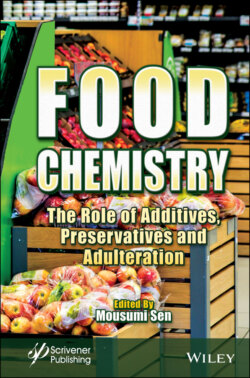Читать книгу Food Chemistry - Группа авторов - Страница 70
2.3.1 Preservatives
ОглавлениеThe food additives under this category are used for the preservation of the food. Food may be easily spoiled by the microorganism or by chemical or enzymatic reaction. The addition of preservative may inhibit the growth of spoilage microorganism or they may inhibit chemical and enzymatic reactions. The food preservatives may be of following three types.
i. Antimicrobials: These additives are added for their ability to inhibit the growth of microorganism. Common additives include benzoates, sorbate, acetic acid, nitrate and nitrites, sulfur dioxide, antibiotics, and phosphates. The overall mode of action of these antimicrobial compounds includes reduced water availability and increased acidity. Natural antimicrobials have the dual benefit that they can inhibit the microorganism as well as make the food safe for eat. They may be derived from microorganism or animal or plant source. Some examples of natural alternative of food preservative include Natamycin, which is an antibiotic selectively that inhibits mold but the growth of bacteria required for ripening of cheese. Nisin and Pediocin are bacteriocin produced by microorganism that is effective on other microorganism. Lysozyme, enzyme lactoperoxidase, and lactoferrin are examples of antimicrobial derived from animal source. Antimicrobial extracted from plant source includes essential oils.
ii. Antioxidants: Antioxidants are additives that are added in to the food to prevent the oxidation reaction. In food material, two types of oxidation reaction may occur: a. enzymatic oxidation of fruits and vegetables; and b. oxidation and rancidity of fats and oils. Antioxidants used in the food material are of following five types:a. radical scavenger or chain breaking antioxidant that is primary antioxidant and it binds with the free radical formed during oxidation reaction, thus preventing the chain reaction;b. chelator binds with metal and prevents them from radical formation;c. quencher that inactivate high energy oxidant;d. oxygen scavenger that removes oxygen from the system;e. antioxidant regenerator that regenerates the antioxidants.Polyphenols are natural antioxidants like flavonoids, tannins, lignans, and coumarins. Natural antioxidant also includes Ferulic acid, Catechin, Ascorbic acid, Tocopherol, Carotenoids like Lycopene, and β-carotene. They are generally used as plant extracts. Synthetic antioxidants include Butylated Hydoxy Anisole (BHA), Butylated Hydroxy Toluene (BHT), tbutylhydroquinone (TBHQ), gallate, and stannous chloride [8–10].In contrast to synthetic antioxidant scientists are finding alternative source of antioxidant in nature. They found that algae contain natural antioxidative compounds that affect various pathogenic organisms with low-cost isolation process. The main antioxidant includes vitamin C and E, carotenoids, polyphenols, and chlorophyll. The red and brown algae contain high levels of folic acid and folate. Two species of cyanobacteria Spirulina platensis and Spirulina maxima are considered as supplements. They have the capacity of lowering lipid content in human body, antioxidant and anti-inflammatory effect. They have high nutritional value. They are considered as important food during long term space mission by NASA. Other important algae include Chlorella vulgaris, Phaeodactylum tricornutum, Gayralia oxysperma, Chaetomorpha antennina, Sargassum vulgare, and Chondrus crispus. They have high antioxidant capacity and have a potential to act as a source of natural antioxidant.
iii. Anti-browning agent: The development of brown or gray or black color in food product is due to browning reaction that may be of two types.a. Enzymatic browning that makes the formation of quinones by the oxidation of polyphenols in presence of polyphenol oxidase. It can be prevented by blanching, acidification, and addition of sulfites.b. Non-enzymatic browning occurs due to the reaction between reducing sugar and free amino acids resulting melanoidin pigment. It can be prevented by avoiding excessive heat, controlling moisture content, and application of sulfites. Sulfites are used in the form of sodium (or potassium) sulfite, bisulfite, or metabisulfite. Other anti-browning agent includes ascorbic acid, cysteine, and 4-Hexylresorcinol.
